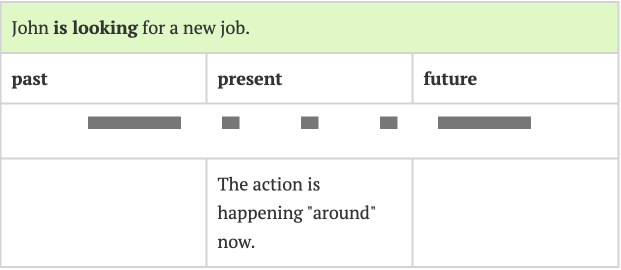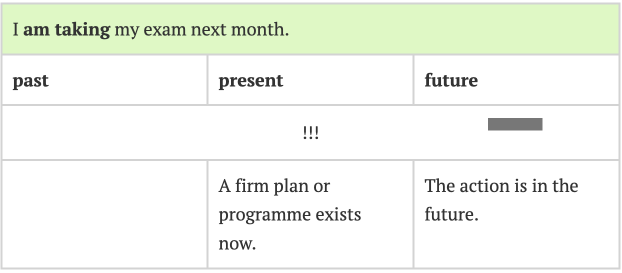(also called Present Progressive)
We often use the Present Continuous tense in English. It is very different from the Present Simple tense, both in structure and in use.
How do we make the Present Continuous tense?
The structure of the Present Continuous tense is:
| subject | + | auxiliary be | + | main verb |
| conjugated in Present Simple | ||||
| am, are, is | present participle (-ing) |
The auxiliary verb (be) is conjugated in the Present Simple: am, are, is
The main verb is invariable in present participle form: -ing
For negative sentences we insert not between the auxiliary verb and the main verb.
For question sentences, we exchange the subject and the auxiliary verb.
Look at these example sentences with the Present Continuous tense:
| subject | auxiliary verb | main verb | |||
|---|---|---|---|---|---|
| + | I | am | speaking | to you. | |
| + | You | are | reading | this. | |
| - | She | is | not | staying | in London. |
| - | We | are | not | playing | football. |
| ? | Is | he | watching | TV? | |
| ? | Are | they | waiting | for John? |
How do we use the Present Continuous tense?
We use the Present Continuous to talk about:
- action happening now
- action in the future
Present Continuous for action happening now
a) for action happening exactly now
| I am eating my lunch. | ||
| past | present | future |
| The action is happening now. | ||
Look at these images. Right now you are looking at this screen and at the same time...
| the pages are turning | the candle is burning | the numbers are spinning |
b) for action happening around now
The action may not be happening exactly now, but it is happening just before and just after now, and it is not permanent or habitual.

Look at these examples:
- Muriel is learning to drive.
- I am living with my sister until I find an apartment.
Present Continuous for the future
We can also use the Present Continuous tense to talk about the future - if we add a future word!! We must add (or understand from the context) a future word. "Future words" include, for example, tomorrow, next year, in June, at Christmas etc. We only use the Present Continuous tense to talk about the future when we have planned to do something before we speak. We have already made a decision and a plan before speaking.

Look at these examples:
- We 're eating at Joe's Cafe tonight. We've already booked the table..
- They can play tennis with you tomorrow. They're not working.
- When are you starting your new job?
In these examples, a firm plan or programme exists before speaking. The decision and plan were made before speaking.
How do we spell the Present Continuous tense?
We make the Present Continuous tense by adding -ing to the base verb. Normally it's simple: we just add -ing. But sometimes we have to change the word a little. Perhaps we double the last letter, or we drop a letter. Here are the rules to help you know how to spell the Present Continuous tense.
| Basic rule | Just add -ing to the base verb: | ||||||||||
|---|---|---|---|---|---|---|---|---|---|---|---|
| work | → | working | |||||||||
| play | → | playing | |||||||||
| assist | → | assisting | |||||||||
| see | → | seeing | |||||||||
| be | → | being | |||||||||
| Exception | If the base verb ends in consonant + stressed vowel + consonant, double the last letter:
| ||||||||||
| stop | → | stopping | |||||||||
| run | → | running | |||||||||
| begin | → | beginning | |||||||||
| Note that this exception does not apply when the last syllable of the base verb is not stressed: | |||||||||||
| open | → | opening | |||||||||
| Exception | If the base verb ends in ie , change the ie to y: | ||||||||||
| lie | → | lying | |||||||||
| die | → | dying | |||||||||
| Exception | If the base verb ends in vowel + consonant + e, omit the e: | ||||||||||
| come | → | coming | |||||||||
| mistake | → | mistaking | |||||||||
sources : Original Link